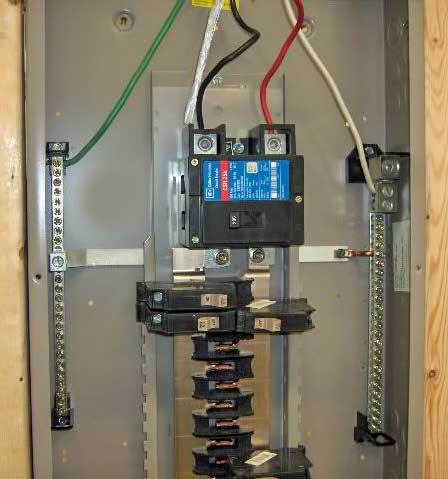You have 240 V coming into the house with a neutral. The neutral splits the voltage in two. If you measured the voltage between the two hots feeding the house, you see 240v. If you measure between each hot and the neutral, you get 120v. Say your panel is all 120v circuits, half of the house is on one side of the incoming line and the other half of the house is on another.
Maybe it is easier to think about in terms of batteries. Say you have two 6v batteries. Connect the + of one to the negative of the other. If you now measure the voltage between the + of one battery and the - of the other, the voltage is 12v, right? This is how you can think about the supply to the house. Now if you measure between the + and - of either battery, each is still 6v (this is like your 120v circuits). So 240v = 2 batteries, 120v = 1 battery. Some 120v circuits are on battery #1, and the rest are on battery #2.
Now with the house voltage, the + and - flip back and forth. So, when circuits on battery #1 are + compared to neutral, the circuits on battery #2 are - compared to neutral.
Oh ok.....My power meter and main panel box is outside. I have both 120 and 240 coming into the house depending on what appliance your checking at.
I found this info on multibranch.
.......................................................................................................................................................................
By David Herres
The following article was written when NEC 2005 was in force. NEC 2008 contains one significant Code change. Instead of only certain sensitive multiwire branch circuits, now all multiwire branch circuits must be protected by a double-pole breaker, not two single-pole breakers. In all cases, two single-pole breakers, linked by a listed device, are equivalent to a double-pole breaker.
Another important NEC 2008 change is that the ungrounded and grounded conductors of each multiwire branch circuit must be grouped by wire ties or similar means in at least one location within the panelboard or other point of origination. An exception provides that the requirement for grouping does not apply if the circuit enters from a cable or raceway unique to the circuit that makes the grouping obvious.
The very concept of a multiwire branch circuit, sharing a neutral between two circuits, appears designed to throw apprentice electricians into severe anxiety and disapproval.
It would seem obvious that two hot legs, both loaded close to maximum, would heat their shared neutral to such an extent that it would glow red hot as it passed through all that flammable material present in the walls of a wood frame building. Wouldn't it be best to call it "a multicircuit branch wire" and ban it forever?
Savvy electricians know otherwise and indeed the careful NEC allows a multiwire branch circuit if used properly. Actually such an arrangement, besides being Code compliant, has a few advantages and efficiencies which make it an attractive option. But there are some severe drawbacks as we shall see, and it may be that the outraged apprentices are right.
The whole idea is that the two hot wires have to be connected to different phases. Then, the neutral carries only the unbalanced current, the difference at any moment, between the more heavily loaded leg and its lighter colleague. In a single-phase circuit the neutral carries the most current when one leg is fully loaded (just under the amount that would trip the circuit breaker) and the other leg is not loaded at all. Then, as the amount of current flowing through the other leg increases, the neutral cools down. When both legs are equally loaded the two return flows in the neutral cancel and it is like the white wire is not there. In a run of conduit there is actually less heat than if the same two loads were on separate two-wire circuits. Besides saving wire, it is sometimes possible to use smaller conduit and on long runs voltage drop can be significantly lower. Additionally, 12-3 type NM is easier to install because it is round. There is definitely money to be saved.
Before considering the downside of these circuits that claim to eliminate a redundant neutral, let's see what NEC 2005 has to say.
The first mention is in Article 100-I Definitions. (Its presence there indicates that multiwire branch circuits are going to appear in more than one place in the Code. In fact, requirements are in eight locations.) "Branch Circuit, Multiwire. A branch circuit that consists of two or more ungrounded conductors that have a voltage between them, and a grounded conductor that has equal voltage between it and each ungrounded conductor of the circuit and that is connected to the neutral or grounded conductor of the system."
The main concept embodied in this definition is that the ungrounded conductors have to have voltage between them; that is they cannot be connected to the same leg. If they were connected to the same leg, the apprentice's worst fear would be realized - the shared neutral's ampacity would soar. Most electrical mistakes resulting in overloads will trip out the circuit breaker providing warning that something is wrong. But a misfed multiwire branch circuit will silently heat the neutral until it either burns clear inside an enclosure or ignites flammable building material resulting in property loss or worse.

